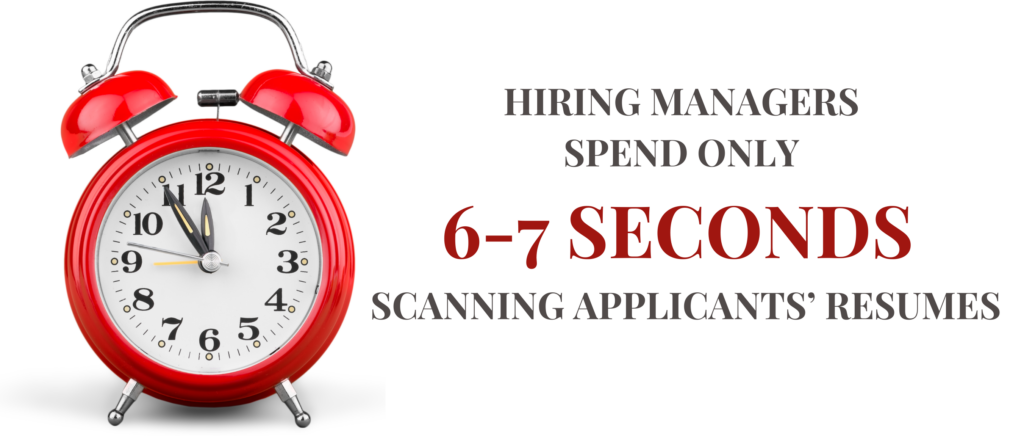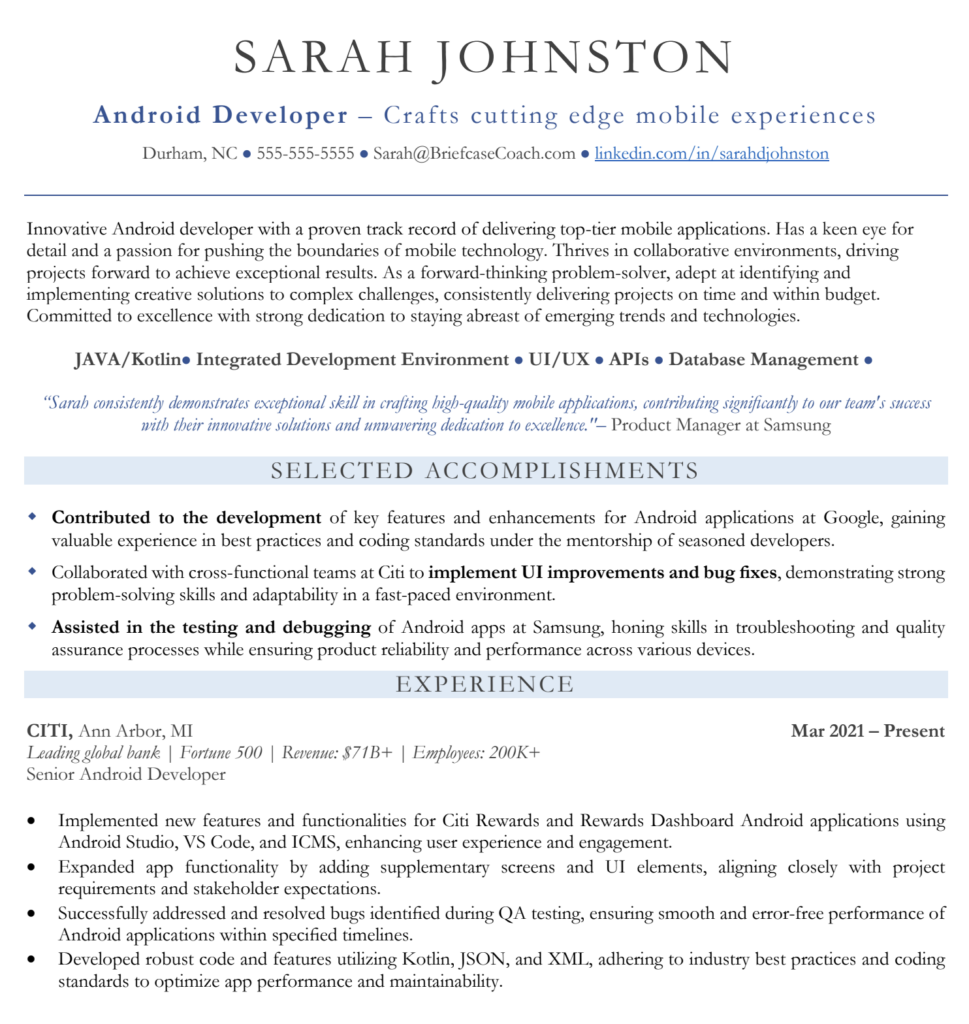In a competitive job market, dusting off the resume you used three jobs ago will not help you stand out. Knowing how to write a senior executive resume will help you highlight your achievements and showcase your personal brand. A well-done resume will also help employers know if you are aligned with the corporate culture. A tailored executive resume makes a strong impression on your network and passes through Applicant Tracking Systems (ATS) for online job searches. This article will guide you in crafting an impressive senior executive resume.
Understanding the Needs of Recruiters and Senior Executive Job-seekers
A recent study showed that recruiters look at resumes for about seven seconds before deciding to read on or pass—seven seconds to make an impression. For senior-level roles, recruiters face the challenge of talent scarcity and high expectations among disparate stakeholders, including board members, CEOs, and other senior leaders. They must adapt to constantly evolving industry landscapes and evaluate soft skills, such as emotional intelligence and interpersonal skills.

Meanwhile, senior executives are facing challenges in 2024, too. The economic downturn in 2023 meant many companies were forced to reduce their workforces. As executives pursue fewer roles in a hesitant job market, they must consider how to compete with qualified candidates. Age discrimination could be a factor, or you could be navigating industry transitions. Tailoring your resume to your targeted industry and position—along with other best practices—can help move your resume into the “yes” pile.
Structuring the Senior Executive Resume
A standout executive resume should be visually appealing and reader-friendly. Though many options exist to present your personal branding, some elements are must-haves. One is your contact information, including name, phone number, email, a working link to your LinkedIn profile, and sometimes, your city and state (never your full address), professional summary, and employment history. Using color, whether in text, shading, or lines, can add visual interest and bring the reader’s eye to impactful details. Maintaining plenty of white space – not cramming the page full of text – aids in making your resume digestible.

Excellent executive resumes are also organized into sections to highlight key achievements and skills at a glance. These sections could be Career Highlights, Skills or Competencies, Speaking Engagements, and Awards. These sections are a potent use of the top third to half of the first page to capture the recruiter’s attention and are easy places to use selected keywords that align with the job you’re seeking. Look to these places to customize your resume later for each potential role.
Write an Executive Resume with a Compelling Professional Summary
A professional summary, which appears just below your contact information, vastly differs from the outdated career objectives trend. The summary captures a recruiter’s attention by sharing your field of expertise, industry, key skills, and accomplishments. It also offers a glimpse into your personality and leadership style. The professional summary should be concise, three to four lines. Consider: what are you best known for? How would peers describe you?
The Employment History Section: Showcase Achievements and Impact
Showcasing your results in the employment section of your resume is another highly impactful way to differentiate yourself. Who would you hire: (a) someone who claims to have increased revenue or (b) someone who increased revenue by $10 million in 8 months? Keep track or look back to quantify your results. Then align those results to the needs of the potential role.
Making those connections will put you a step ahead of other applicants. Provide context to accomplishments by including how you achieved business results and growth to add value to your bullets. Frameworks for crafting bullet points to describe your successes include the STAR (situation, task, action, and result) and RAS (result, action, and situation) methods. Successes related to the bottom line, business growth, or operational efficiency are important. For senior executive jobseekers, employers will also want to see people-related metrics that indicate people like working for you, such as employee engagement or staff retention stats.
Examples of results-oriented resume bullet points:
- Grew accounts by 20% YOY from $3M to $30M through refined sales strategy targeting distributors.
- Restructured 4 acquired teams to optimize performance with 95% talent retention.
- Accelerated revenue by 250% by devising channel strategy, installing hungry sales team and teaching solution-based selling.
- Maintained high brand affinity (70 NPS score) during the accelerated growth phase by focusing on upgraded customer experience.
There are different formats for executive resumes, and most commonly, the employment experience section is in reverse chronological order. Be sure to include each company’s name, a short information line for context on the industry, size and customers, job title, and dates of employment. Typically, the current or most recent job gets the most space to showcase its relevance to the targeted role.
Addressing Resume Gaps and Challenges
Knowing how to handle career challenges on a resume can also make your job-seeking process easier. Though candidates should never lie, there are strategies to address employment gaps, career transitions or limited experience. The best practice for employment dates is to include only years and not months. For short gaps, including only the years will make a few months between jobs virtually disappear. For longer breaks, you may consider whether side projects could be grouped together in a consulting or self-employed role. Sometimes a simple line of explanation, such as Sabbatical to New Zealand, 2017-2018, or Full Time Caregiver, 2014-2017, is enough. Hiring managers and recruiters are humans, too, and tend to prefer honesty. For candidates looking to shift industries or career tracks, showcasing transferrable skills is critical. For example, a marketing executive interested in human resources might highlight restructuring teams and the professional development program she started. A candidate with multiple shorter-term job stints may consider including information about his designated projects coming to a close.
Tailoring Executive Resumes to the Targeted Industry and Position
Whether you are addressing tricky situations or simply looking for the next step, tailoring the resume is imperative. Throughout your resume, you should ensure that your word choices, tone, and branding match with the industry. Take a look at job descriptions for roles you might consider: do you see any consistent requirements or skills? Use them in your resume. You could also try asking AI for skills expected for your next role. Have you positioned yourself at the forefront of innovation in your industry, such as using machine learning to streamline operations or advanced analytics to predict talent risks? Highlight areas that show you are ready to handle what’s next in your field. Even your font and color choices convey information. A traditional Serif font and muted colors may suit a more conservative industry. A simple sans Serif font and brighter hues are the way to go for a high-tech or creative role.
Proofreading and Finalizing a Senior-Level Resume
Writing a senior executive resume takes a lot of time, research, and reflection. Don’t let a typo undo your hard work. Proofreading is important to ensure a flawless and error-free resume. Common mistakes include misspelled words, inconsistent use of periods (using them for some bullets but not others), inconsistent formatting (too many font sizes or too many bullet types), and inaccurate dates. Use a proofreading website like Grammarly.com to shows grammatical errors. Then ask a trusted friend, colleague or career coach to ensure your resume is the best reflection of you.
We recommend professionals update their resumes continually and maintain a system of collecting accomplishments so that this process becomes easier.
A well-crafted senior executive resume that is organized, tailored to your desired role, and clearly articulates your value proposition and accomplishments is a vital first step in securing an interview for your next career advancement. We encourage you to use this guidance to create a powerful resume that stands out in this competitive job market.
